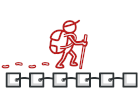
PHP 迭代器模式讲解和代码示例
迭代器是一种行为设计模式, 让你能在不暴露复杂数据结构内部细节的情况下遍历其中所有的元素。
在迭代器的帮助下, 客户端可以用一个迭代器接口以相似的方式遍历不同集合中的元素。
复杂度:
流行度:
使用示例: 该模式在 PHP 代码中很常见。 许多框架和程序库都会使用它来提供遍历其集合的标准方式。
PHP 拥有内置的迭代器接口, 可用于创建与其他 PHP 代码兼容的自定义迭代器。
识别方法: 迭代器可以通过导航方法 (例如 next和 previous等) 来轻松识别。 使用迭代器的客户端代码可能没有其所遍历的集合的直接访问权限。
概念示例
本例说明了迭代器设计模式的结构并重点回答了下面的问题:
- 它由哪些类组成?
- 这些类扮演了哪些角色?
- 模式中的各个元素会以何种方式相互关联?
了解该模式的结构后, 你可以更容易地理解下面基于真实世界的 PHP 应用案例。
index.php: 概念示例
<?php namespace RefactoringGuru\Iterator\Conceptual; /** * Concrete Iterators implement various traversal algorithms. These classes * store the current traversal position at all times. */ class AlphabeticalOrderIterator implements \Iterator { /** * @var WordsCollection */ private $collection; /** * @var int Stores the current traversal position. An iterator may have a * lot of other fields for storing iteration state, especially when it is * supposed to work with a particular kind of collection. */ private $position = 0; /** * @var bool This variable indicates the traversal direction. */ private $reverse = false; public function __construct($collection, $reverse = false) { $this->collection = $collection; $this->reverse = $reverse; } public function rewind() { $this->position = $this->reverse ? count($this->collection->getItems()) - 1 : 0; } public function current() { return $this->collection->getItems()[$this->position]; } public function key() { return $this->position; } public function next() { $this->position = $this->position + ($this->reverse ? -1 : 1); } public function valid() { return isset($this->collection->getItems()[$this->position]); } } /** * Concrete Collections provide one or several methods for retrieving fresh * iterator instances, compatible with the collection class. */ class WordsCollection implements \IteratorAggregate { private $items = []; public function getItems() { return $this->items; } public function addItem($item) { $this->items[] = $item; } public function getIterator(): Iterator { return new AlphabeticalOrderIterator($this); } public function getReverseIterator(): Iterator { return new AlphabeticalOrderIterator($this, true); } } /** * The client code may or may not know about the Concrete Iterator or Collection * classes, depending on the level of indirection you want to keep in your * program. */ $collection = new WordsCollection(); $collection->addItem("First"); $collection->addItem("Second"); $collection->addItem("Third"); echo "Straight traversal:\n"; foreach ($collection->getIterator() as $item) { echo $item . "\n"; } echo "\n"; echo "Reverse traversal:\n"; foreach ($collection->getReverseIterator() as $item) { echo $item . "\n"; } Output.txt: 执行结果
Straight traversal: First Second Third Reverse traversal: Third Second First 真实世界示例
由于 PHP 已有内置的迭代器接口并能方便地与 foreach 循环整合, 因此你很轻松就能为任何数据结构创建你自己的迭代器。
该迭代器模式示例可以轻松地访问 CSV 文件。
index.php: 真实世界示例
<?php namespace RefactoringGuru\Iterator\RealWorld; /** * CSV File Iterator. * * @author Josh Lockhart */ class CsvIterator implements \Iterator { const ROW_SIZE = 4096; /** * The pointer to the CSV file. * * @var resource */ protected $filePointer = null; /** * The current element, which is returned on each iteration. * * @var array */ protected $currentElement = null; /** * The row counter. * * @var int */ protected $rowCounter = null; /** * The delimiter for the CSV file. * * @var string */ protected $delimiter = null; /** * The constructor tries to open the CSV file. It throws an exception on * failure. * * @param string $file The CSV file. * @param string $delimiter The delimiter. * * @throws \Exception */ public function __construct($file, $delimiter = ',') { try { $this->filePointer = fopen($file, 'rb'); $this->delimiter = $delimiter; } catch (\Exception $e) { throw new \Exception('The file "' . $file . '" cannot be read.'); } } /** * This method resets the file pointer. */ public function rewind(): void { $this->rowCounter = 0; rewind($this->filePointer); // Read the first row to initialize $this->currentElement = fgetcsv($this->filePointer, self::ROW_SIZE, $this->delimiter); } /** * This method returns the current CSV row as a 2-dimensional array. * * @return array The current CSV row as a 2-dimensional array. */ public function current(): array { return $this->currentElement ?: []; } /** * This method returns the current row number. * * @return int The current row number. */ public function key(): int { return $this->rowCounter; } /** * This method moves to the next element. */ public function next(): void { if (is_resource($this->filePointer)) { $this->currentElement = fgetcsv($this->filePointer, self::ROW_SIZE, $this->delimiter); $this->rowCounter++; } } /** * This method checks if the current position is valid. * * @return bool If the current position is valid. */ public function valid(): bool { if ($this->currentElement === false) { if (is_resource($this->filePointer)) { fclose($this->filePointer); } return false; } return is_resource($this->filePointer); } } /** * The client code. */ $csv = new CsvIterator(__DIR__ . '/cats.csv'); foreach ($csv as $key => $row) { print_r($row); } Output.txt: 执行结果
Array ( [0] => Name [1] => Age [2] => Owner [3] => Breed [4] => Image [5] => Color [6] => Texture [7] => Fur [8] => Size ) Array ( [0] => Steve [1] => 3 [2] => Alexander Shvets [3] => Bengal [4] => /cats/bengal.jpg [5] => Brown [6] => Stripes [7] => Short [8] => Medium ) Array ( [0] => Siri [1] => 2 [2] => Alexander Shvets [3] => Domestic short-haired [4] => /cats/domestic-sh.jpg [5] => Black [6] => Solid [7] => Medium [8] => Medium ) Array ( [0] => Fluffy [1] => 5 [2] => John Smith [3] => Maine Coon [4] => /cats/Maine-Coon.jpg [5] => Gray [6] => Stripes [7] => Long [8] => Large ) 


